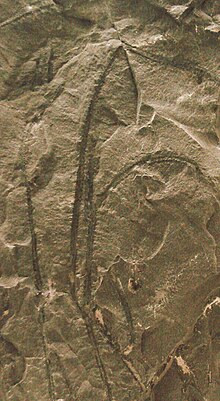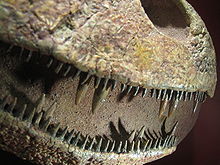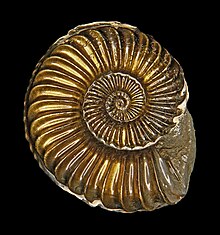Portal:Devonian
The Devonian Portal
The Devonian (/dɪˈvoʊni.ən, dɛ-/ də-VOH-nee-ən, deh-) is a geologic period and system of the Paleozoic era during the Phanerozoic eon, spanning 60.3 million years from the end of the preceding Silurian period at 419.2 million years ago (Ma), to the beginning of the succeeding Carboniferous period at 358.9 Ma. It is named after Devon, South West England, where rocks from this period were first studied.
The first significant evolutionary radiation of life on land occurred during the Devonian, as free-sporing land plants (pteridophytes) began to spread across dry land, forming extensive coal forests which covered the continents. By the middle of the Devonian, several groups of vascular plants had evolved leaves and true roots, and by the end of the period the first seed-bearing plants (pteridospermatophytes) appeared. This rapid evolution and colonization process, which had begun during the Silurian, is known as the Silurian-Devonian Terrestrial Revolution. The earliest land animals, predominantly arthropods such as myriapods, arachnids and hexapods, also became well-established early in this period, after beginning their colonization of land at least from the Ordovician period.
Fishes, especially jawed fish, reached substantial diversity during this time, leading the Devonian to often be dubbed the Age of Fishes. The armored placoderms began dominating almost every known aquatic environment. In the oceans, cartilaginous fishes such as primitive sharks became more numerous than in the Silurian and Late Ordovician. Tetrapodomorphs, which include the ancestors of all four-limbed vertebrates (i.e. tetrapods), began diverging from freshwater lobe-finned fish as their more robust and muscled pectoral and pelvic fins gradually evolved into forelimbs and hindlimbs, though they were not fully established for life on land until the Late Carboniferous. (Full article...)
Selected Devonian Article
The Late Devonian extinction consisted of several extinction events in the Late Devonian Epoch, which collectively represent one of the five largest mass extinction events in the history of life on Earth. The term primarily refers to a major extinction, the Kellwasser event, also known as the Frasnian-Famennian extinction, which occurred around 372 million years ago, at the boundary between the Frasnian stage and the Famennian stage, the last stage in the Devonian Period. Overall, 19% of all families and 50% of all genera became extinct. A second mass extinction called the Hangenberg event, also known as the end-Devonian extinction, occurred 359 million years ago, bringing an end to the Famennian and Devonian, as the world transitioned into the Carboniferous Period.
Although it is well established that there was a massive loss of biodiversity in the Late Devonian, the timespan of this event is uncertain, with estimates ranging from 500,000 to 25 million years, extending from the mid-Givetian to the end-Famennian. Some consider the extinction to be as many as seven distinct events, spread over about 25 million years, with notable extinctions at the ends of the Givetian, Frasnian, and Famennian stages.
By the Late Devonian, the land had been colonized by plants and insects. In the oceans, massive reefs were built by corals and stromatoporoids. Euramerica and Gondwana were beginning to converge into what would become Pangaea. The extinction seems to have only affected marine life. Hard-hit groups include brachiopods, trilobites, and reef-building organisms; the latter almost completely disappeared. The causes of these extinctions are unclear. Leading hypotheses include changes in sea level and ocean anoxia, possibly triggered by global cooling or oceanic volcanism. The impact of a comet or another extraterrestrial body has also been suggested, such as the Siljan Ring event in Sweden. Some statistical analysis suggests that the decrease in diversity was caused more by a decrease in speciation than by an increase in extinctions. This might have been caused by invasions of cosmopolitan species, rather than by any single event. Placoderms were hit hard by the Kellwasser event and completely died out in the Hangenberg event, but most other jawed vertebrates were less strongly impacted. Agnathans (jawless fish) were in decline long before the end of the Frasnian and were nearly wiped out by the extinctions. (Full article...)List of selected Devonian articles
|
|---|
Selected Devonian land plant article
List of selected Devonian articles
|
|---|
Selected Devonian formation
List of selected Devonian formation articles
|
|---|
Selected Devonian fish article
Tristichopterids (Tristichopteridae) were a diverse and successful group of fish-like tetrapodomorphs living throughout the Middle and Late Devonian. They first appeared in the Eifelian stage of the Middle Devonian. Within the group sizes ranged from a few tens of centimeters (Tristichopterus) to several meters (Hyneria and Eusthenodon).
Some tristichopterids share some of the features of the elpistostegalians, a diverse clade of tetrapodomorphs close to the origin of (and including) tetrapods.[better source needed] This mainly concerns the shape of the skull and a reduction in size of the posterior fins.
An old and persistent notion is that Eusthenopteron was able to crawl onto land using its fins. However, there is no evidence actually supporting this idea. All tristichopterids had become extinct by the end of the Late Devonian. (Full article...)Selected Devonian invertebrate
Ammonoids are extinct spiral shelled cephalopods comprising the subclass Ammonoidea. They are more closely related to living coleoids (i.e., octopuses, squid and cuttlefish) than they are to shelled nautiloids (such as the living Nautilus). The earliest ammonoids appeared during the Devonian, with the last species vanishing during or soon after the Cretaceous–Paleogene extinction event. They are often called ammonites, which is most frequently used for members of the order Ammonitida, the only living group of ammonoids from the Jurassic up until their extinction.
Ammonites are excellent index fossils, and linking the rock layer in which a particular species or genus is found to specific geologic time periods is often possible. Their fossil shells usually take the form of planispirals, although some helically spiraled and nonspiraled forms (known as heteromorphs) have been found.
The name "ammonite", from which the scientific term is derived, was inspired by the spiral shape of their fossilized shells, which somewhat resemble tightly coiled rams' horns. Pliny the Elder (d. 79 AD near Pompeii) called fossils of these animals ammonis cornua ("horns of Ammon") because the Egyptian god Ammon (Amun) was typically depicted wearing rams' horns. Often, the name of an ammonite genus ends in -ceras, which is from κέρας (kéras) meaning "horn". (Full article...)List of selected Devonian invertebrates articles
|
|---|
Need help?
Do you have a question about Devonian that you can't find the answer to?
Consider asking it at the Wikipedia reference desk.
Subcategories
Related portals
Associated Wikimedia
The following Wikimedia Foundation sister projects provide more on this subject:
-
Commons
Free media repository -
Wikibooks
Free textbooks and manuals -
Wikidata
Free knowledge base -
Wikinews
Free-content news -
Wikiquote
Collection of quotations -
Wikisource
Free-content library -
Wikiversity
Free learning tools -
Wiktionary
Dictionary and thesaurus



























